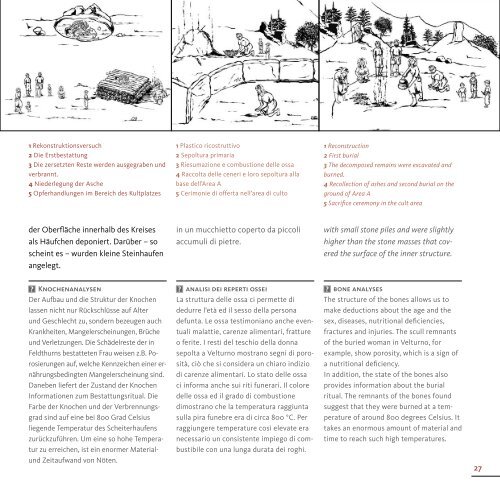Un regno di pietre. - Rete Civica dell'Alto Adige
Un regno di pietre. - Rete Civica dell'Alto Adige
Un regno di pietre. - Rete Civica dell'Alto Adige
Create successful ePaper yourself
Turn your PDF publications into a flip-book with our unique Google optimized e-Paper software.
1 Rekonstruktionsversuch<br />
2 Die Erstbestattung<br />
3 Die zersetzten Reste werden ausgegraben und<br />
verbrannt.<br />
4 Niederlegung der Asche<br />
5 Opferhandlungen im Bereich des Kultplatzes<br />
der Oberfläche innerhalb des Kreises<br />
als Häufchen deponiert. Darüber – so<br />
scheint es – wurden kleine Steinhaufen<br />
angelegt.<br />
Knochenanalysen<br />
Der Aufbau und <strong>di</strong>e Struktur der Knochen<br />
lassen nicht nur Rückschlüsse auf Alter<br />
und Geschlecht zu, sondern bezeugen auch<br />
Krankheiten, Mangelerscheinungen, Brüche<br />
und Verletzungen. Die Schädelreste der in<br />
Feldthurns bestatteten Frau weisen z.B. Porosierungen<br />
auf, welche Kennzeichen einer ernährungsbe<strong>di</strong>ngten<br />
Mangelerscheinung sind.<br />
Daneben liefert der Zustand der Knochen<br />
Informationen zum Bestattungsritual. Die<br />
Farbe der Knochen und der Verbrennungsgrad<br />
sind auf eine bei 800 Grad Celsius<br />
liegende Temperatur des Scheiterhaufens<br />
zurückzuführen. Um eine so hohe Temperatur<br />
zu erreichen, ist ein enormer Material-<br />
und Zeitaufwand von Nöten.<br />
1 Plastico ricostruttivo<br />
2 Sepoltura primaria<br />
3 Riesumazione e combustione delle ossa<br />
4 Raccolta delle ceneri e loro sepoltura alla<br />
base dell’Area A<br />
5 Cerimonie <strong>di</strong> offerta nell’area <strong>di</strong> culto<br />
in un mucchietto coperto da piccoli<br />
accumuli <strong>di</strong> <strong>pietre</strong>.<br />
analisi dei reperti ossei<br />
La struttura delle ossa ci permette <strong>di</strong><br />
dedurre l’età ed il sesso della persona<br />
defunta. Le ossa testimoniano anche eventuali<br />
malattie, carenze alimentari, fratture<br />
o ferite. I resti del teschio della donna<br />
sepolta a Velturno mostrano segni <strong>di</strong> porosità,<br />
ciò che si considera un chiaro in<strong>di</strong>zio<br />
<strong>di</strong> carenze alimentari. Lo stato delle ossa<br />
ci informa anche sui riti funerari. Il colore<br />
delle ossa ed il grado <strong>di</strong> combustione<br />
<strong>di</strong>mostrano che la temperatura raggiunta<br />
sulla pira funebre era <strong>di</strong> circa 800 °C. Per<br />
raggiungere temperature così elevate era<br />
necessario un consistente impiego <strong>di</strong> combustibile<br />
con una lunga durata dei roghi.<br />
1 Reconstruction<br />
2 First burial<br />
3 The decomposed remains were excavated and<br />
burned.<br />
4 Recollection of ashes and second burial on the<br />
ground of Area A<br />
5 Sacrifice ceremony in the cult area<br />
with small stone piles and were slightly<br />
higher than the stone masses that covered<br />
the surface of the inner structure.<br />
bone analyses<br />
The structure of the bones allows us to<br />
make deductions about the age and the<br />
sex, <strong>di</strong>seases, nutritional deficiencies,<br />
fractures and injuries. The scull remnants<br />
of the buried woman in Velturno, for<br />
example, show porosity, which is a sign of<br />
a nutritional deficiency.<br />
In ad<strong>di</strong>tion, the state of the bones also<br />
provides information about the burial<br />
ritual. The remnants of the bones found<br />
suggest that they were burned at a temperature<br />
of around 800 degrees Celsius. It<br />
takes an enormous amount of material and<br />
time to reach such high temperatures.<br />
27



